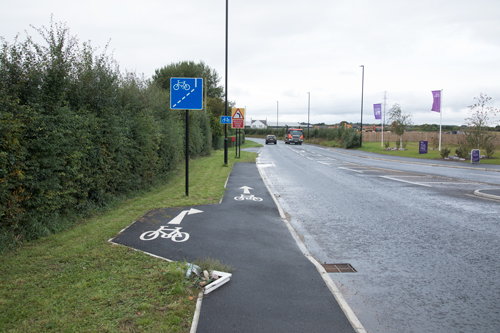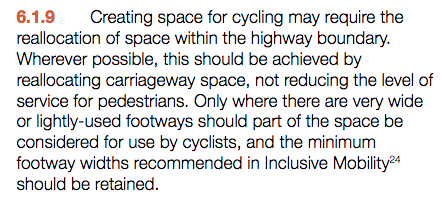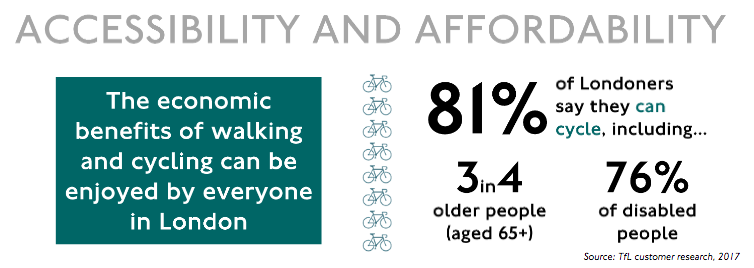People Who Want a Cycle Network in Theory but not in Practice

People who oppose specific proposals for cycle infrastructure rarely admit that they are against the creation of a cycle network in principle. They are almost always in favour of cycle paths – just not here, not now, and not this design.
They want a cycle network in theory but not in practice; they are Theorists.
I’ve heard it again and again in relation to the Otley Road cycleway, Beech Grove, and Harrogate Station Gateway. Here are some of the most common deflections and excuses used by Theorists.
1) Not Here – Build a Cycle Path Over There
Theorists want cycle paths, but not on the streets they use on a daily basis.
“I think they should only build cycle paths on new housing estates”. Well they are building rubbish shared use cycle paths on new housing estates, and they don’t go anywhere.

It seems obvious but it needs saying: to enable people to cycle you need a network, not a few isolated bits of cycle infrastructure.

2) Not Now – Can’t You Do it Later?
I’ve heard this in relation to Harrogate Station Gateway. It’s too sudden. It’s too much. Can’t you just change a little bit and leave the meaningful interventions until later?
But we’re starting from a very low base, where most people perceive cycling on the roads as unsafe.

Tinkering around the edges and painting a few more short sections of narrow unprotected cycle lanes isn’t enough.
One of the main lessons from the creation of a bike network in Seville was that if you do it quickly it works, people see that it works, and they support what you did. Tiny incremental changes won’t achieve anything.
3) Not This Design – There’s a Really Wide Pavement Over There
Often Theorists see themselves primarily as motorists, and they want cyclists to GET OUT OF THE WAY.
Perhaps deep down they understand the extent of the priority and privilege given to people driving cars.
Timings of pedestrian crossing lights are set to prioritise “traffic flow”. On roads which are wide enough for more than one lane in either direction, the extra space is also devoted to cars: two traffic lanes, or parked cars – ideally on both sides of the road.
For Theorists there is never enough space for proper protected cycle tracks, because they want to keep it all for cars.
Why can’t you ride on that pavement? It’s wide enough. But LTN 1/20 Cycle Infrastructure Design rightly says that cycling facilities should be created by reallocating space from the carriageway, not by reducing the level of service for pedestrians.

4) Not This Design – It Makes Short Trips by Car Less Convenient for Me
This has been one of the most persistent objections to Beech Grove, but if very short local trips by car are less convenient, that is a good thing.
There are lots of reasons to want short local trips to walked or cycled, not least climate breakdown which is now upon us. It needs dedicated, safe infrastructure for walking and cycling and disincentives for driving.
5) Not This Design – I Park There
Wherever there is extra road space, it has been taken for parking. If we treat parking spaces as sacred, we’re never going to create a quality cycle network.
We need a vision of the way we want people to make short local trips, then we have to implement it. In many cases, this will mean prioritising cycling and walking over storage of private cars on public land.
6) Not This Design – I Want to Keep All the Grass
This is a favourite excuse on Otley Road: grass is sacred ground, and we mustn’t lose a square inch of it – unless it’s for cars or houses of course, in which case it’s fine. In fact grass is only treated as sacred ground in order to object to building cycle tracks.
Do you want to replace grass with houses and driveways beyond Harlow Carr, at Windmill Farm? No problem.
Do you want to build extra traffic lanes at the junction of Otley Road and Harlow Moor Road? No problem.
Do you want to widen the road at the new Harlow Hill Grange development, for a right turn lane and areas of hatching? No problem.

What about a proper cycle track? Oh no, can’t do that – what about the grass?
7) Not This Scheme, a Different One
This is heard in relation to Harrogate Station Gateway – a project which has been worked on for 3 years, which is funded to the tune of £11 million, and which is ready to go.
But for some it’s not quite right. They worry about idling car engines, and they propose something else. How about making West Park and Parliament Street two-way, then you can do what you like to Station Parade.
Well for one thing, making West Park and Parliament Street two-way also involves reducing capacity for motor vehicles, so why would you worry about idling car engines in relation to one scheme but not the other?
More importantly, though, the alternative scheme is not funded, hasn’t been worked up as a project, and therefore won’t happen.
It’s essentially floating plausible-sounding alternatives which are in fact non-alternatives, in an attempt to ensure that nothing happens and to preserve the car-dominated status quo.
8) Let Me Run Through My List of Excuses
Theorists have a list of excuses why no one will ever get around town by bike.
It rains sometimes. Well, most of the time it doesn’t, and when it does Dutch people still manage to cycle.
It’s too hilly. But Harrogate really isn’t the Alps. It’s a compact town, and many trips involve no hills at all. Anyway e-bikes take the effort out of hills. What’s that, you can’t afford an ebike, but you can afford a luxury car?
Older people can’t cycle. Yes, most can, and it’s good for everyone’s health.

The point that Theorists can’t or refuse to grasp is that the biggest obstacle to cycling for short local trips is lack of dedicated space physically protected from traffic. When you provide that, as in the Netherlands and Denmark, people will and do get around by bike in large numbers.
With a proper network of dedicated cycle infrastructure, modal share for cycling can be 30% or more. In Munster, it is 43.5%, vs 34% for the car. It can be done, but only with a proper cycle network. Otherwise, you get a cycling modal share of 2% – the most determined 2% – as in most of the UK.
To reach Net Zero we know that we need a big increase in cycling – a 9-fold increase in York and North Yorkshire, according to the Local Enterprise Partnership’s Emissions Reduction Pathways report.
It’s time to stop deflecting and making excuses. It’s time for all of us to be in favour of creating safe cycle networks – not only in theory but also in practice.

